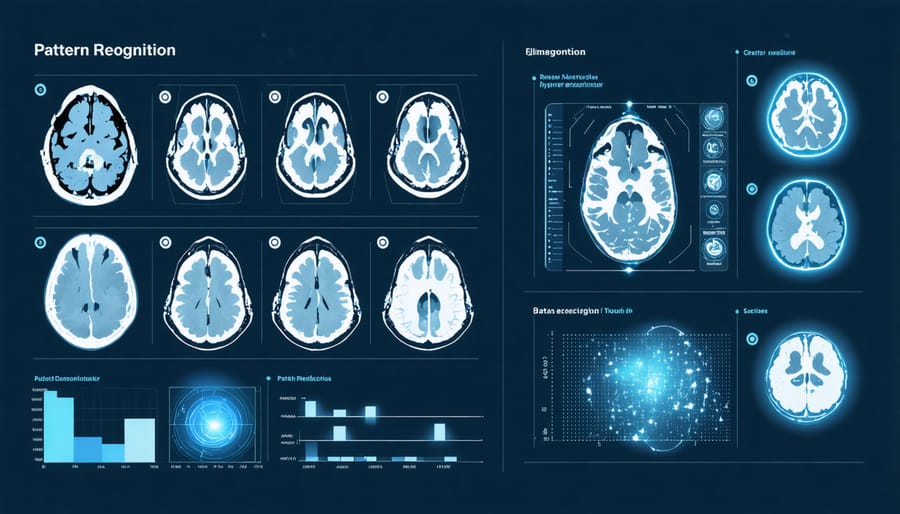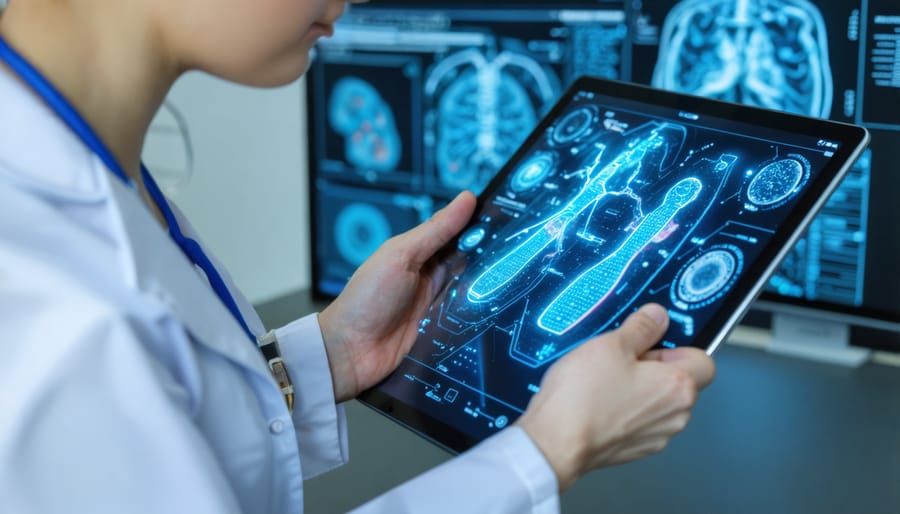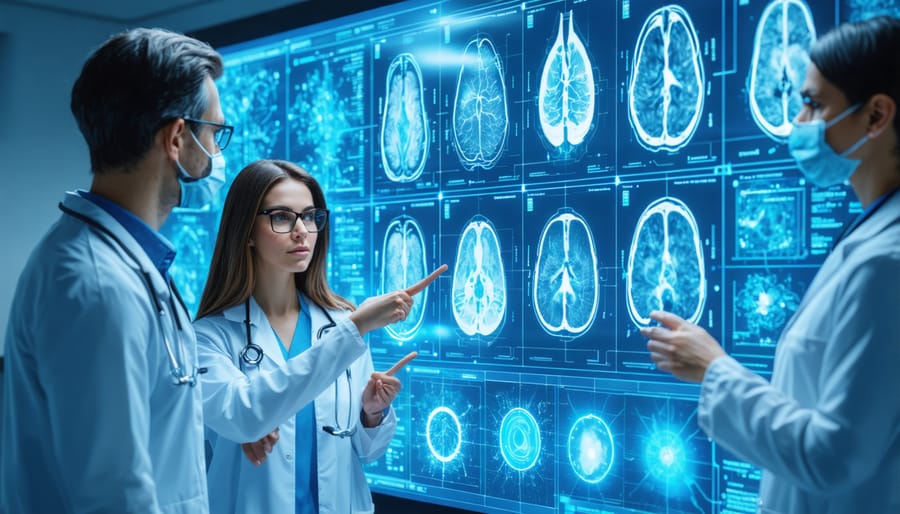Diagnostic AI revolutionizes healthcare by analyzing medical data with unprecedented speed and accuracy, empowering Albertans to take control of their health journey through advanced digital healthcare solutions. These intelligent systems can detect patterns in symptoms, lab results, and medical imaging that might escape the human eye, potentially identifying health issues before they become serious concerns. For patients and healthcare providers alike, AI-powered diagnostics offer a powerful complement to traditional medical expertise, reducing wait times and improving access to specialized care across Alberta’s urban and rural communities. By combining machine learning algorithms with medical knowledge, these tools help create more accurate diagnoses while maintaining the essential human touch in healthcare delivery. The technology represents a significant step forward in preventive medicine, offering personalized health insights that can help Albertans make more informed decisions about their wellbeing.
How AI Diagnostic Tools Work
Pattern Recognition and Machine Learning
Modern diagnostic AI systems work like highly skilled pattern detectors, examining thousands of medical records, test results, and images to spot important health trends. Think of it as having a super-smart assistant that can quickly notice subtle connections that might take human doctors much longer to identify.
These systems learn from vast amounts of healthcare data, becoming better at recognizing signs of various conditions over time. For example, when analyzing chest X-rays, AI can detect early signs of lung conditions by comparing the image with millions of other X-rays it has studied before.
In Alberta’s healthcare facilities, these AI tools are helping doctors analyze blood test results, medical imaging, and even genetic information more efficiently. The AI looks for patterns that might indicate various health conditions, from diabetes to heart disease, often catching early warning signs before they become serious problems.
What makes these systems particularly valuable is their ability to consider multiple factors simultaneously. While a doctor might focus on a few key symptoms, AI can analyze hundreds of data points at once, helping to create a more complete picture of a patient’s health status.

Integration with Health Records
Modern diagnostic AI systems are designed to work seamlessly with existing electronic health records (EHRs), making it easier for healthcare providers to access and use patient information. In Alberta, many medical facilities have already integrated AI tools with their record-keeping systems, allowing doctors to pull up patient histories, test results, and AI-generated insights all in one place.
These integrated systems help reduce duplicate testing and save time by automatically importing relevant patient data into the AI analysis. For example, when you visit your family doctor, they can quickly access your previous test results and medical history, which the AI uses to provide more accurate recommendations.
The connection between AI tools and health records also helps track changes in your health over time. Your healthcare team can spot trends and potential issues earlier, leading to more proactive care. This integration maintains strict privacy standards in line with Alberta’s health information protection laws, ensuring your medical information stays secure and confidential.
For patients, this means smoother appointments, better-coordinated care between different healthcare providers, and more informed medical decisions based on your complete health picture.
Real Benefits for Albertans
Early Detection of Health Issues
Early detection through AI is transforming how we approach healthcare in Alberta, catching potential health issues before they become serious concerns. These smart systems analyze various health indicators – from routine blood work to imaging results – to spot patterns that might escape the human eye.
Think of AI as your health’s early warning system. It can detect subtle changes in your test results or vital signs that might signal the beginning of a health condition, giving you and your healthcare team valuable time to act. For example, AI algorithms can identify early signs of diabetes by analyzing blood sugar patterns, or spot potential heart problems by examining ECG readings.
Here in Alberta, many healthcare facilities are embracing these technologies to enhance preventive care. AI systems can process thousands of medical records and images quickly, helping doctors identify risk factors and potential health issues during routine check-ups. This means more personalized preventive care plans for you and your family.
What makes this technology particularly valuable is its ability to learn and improve over time. As AI systems analyze more health data, they become better at identifying early warning signs specific to different populations and age groups. This continuous learning helps healthcare providers offer more targeted preventive measures and interventions.
Remember, while AI is an powerful tool for early detection, it works best when combined with regular check-ups and open communication with your healthcare provider. Together, they create a comprehensive approach to maintaining your health and catching potential issues early.
Supporting Rural Healthcare Access
For many Albertans living in rural and remote areas, accessing healthcare services has traditionally meant long drives to urban centers. Diagnostic AI is changing this reality by bringing sophisticated medical screening capabilities closer to home. Through innovative technologies and remote healthcare access solutions, rural communities are now benefiting from faster diagnoses and improved health outcomes.
Local health centers are implementing AI-powered diagnostic tools that can analyze medical images, vital signs, and test results on the spot. This means residents in places like Peace River, Fort McMurray, and other remote areas can receive preliminary diagnoses without traveling to Edmonton or Calgary. The technology is particularly valuable for monitoring chronic conditions and catching potential health issues early.
These AI systems are also helping rural healthcare providers make more informed decisions about patient care. When specialists aren’t immediately available, AI can assist local doctors and nurses in identifying urgent cases that need referrals while reassuring patients who can safely be treated locally.
The impact extends beyond convenience. For elderly residents, people with mobility challenges, and those who can’t easily take time off work, this technology makes regular health monitoring more accessible. It’s creating a more equitable healthcare system where your postal code doesn’t determine the quality of care you receive.

Using AI Diagnostic Tools Responsibly
When to Use AI Tools
AI diagnostic tools are most effective when used as part of your overall healthcare strategy, not as a replacement for professional medical care. Consider using these tools when you want to track ongoing health conditions, monitor vital signs, or get preliminary insights about new symptoms.
They’re particularly helpful for regular health monitoring, such as checking blood pressure, blood sugar levels, or heart rhythm patterns. Many Albertans find these tools valuable for managing chronic conditions like diabetes or heart disease, as they provide real-time data and early warning signs of potential issues.
You might also turn to AI diagnostics when you’re looking to establish baseline health measurements or track changes in your condition over time. These tools can help you prepare for medical appointments by gathering detailed health data to share with your healthcare provider.
However, always remember that AI tools should complement, not replace, regular check-ups with your doctor. They’re ideal for routine monitoring and initial assessment but aren’t suitable for emergency situations or serious health concerns. If you experience severe symptoms or sudden health changes, contact your healthcare provider or visit your nearest emergency department immediately.
For best results, use AI diagnostic tools consistently and share the data with your healthcare team to support more informed decision-making about your health.
Working with Healthcare Providers
When discussing AI diagnostic results with your healthcare provider, it’s important to approach the conversation prepared and informed. Start by explaining that you’ve used AI diagnostic tools through approved virtual healthcare platforms, and share specific symptoms or concerns that led you to seek AI assistance.
Keep a record of your AI diagnostic interactions, including dates, symptoms entered, and recommendations received. This information helps your healthcare provider understand your health journey and make more informed decisions. Remember that AI tools are meant to support, not replace, professional medical judgment.
Ask your healthcare provider how they prefer to receive AI diagnostic information and whether they work with specific platforms. Many Alberta doctors now welcome this technology as a way to enhance patient care and early detection of health issues.
Be honest about any self-directed actions you’ve taken based on AI recommendations. This helps your healthcare provider assess both the effectiveness of the AI tool and the appropriateness of your response to its guidance. Together, you can develop a plan that integrates AI insights with traditional medical care for the best possible outcomes.

Looking Ahead: The Future of AI Diagnostics
The future of AI diagnostics looks incredibly promising, especially here in Alberta where we’re seeing increased investment in healthcare technology. In the coming years, we can expect AI diagnostic tools to become more accessible and integrated into our everyday healthcare experiences.
One of the most exciting developments is the potential for personalized medicine. AI systems are becoming better at analyzing individual patient data, including genetic information, lifestyle factors, and medical history, to create tailored treatment plans. This means your healthcare could become as unique as you are.
We’re also seeing progress in early detection capabilities. Future AI systems will likely be able to identify potential health issues months or even years before traditional symptoms appear. For Albertans living in remote communities, this could mean catching health concerns early, even with limited access to specialists.
Mobile health applications powered by AI are set to revolutionize home monitoring. Imagine having a smart device that can track your vital signs and alert you to potential health issues before they become serious. This technology could be particularly valuable for managing chronic conditions like diabetes or heart disease.
While these advancements are exciting, our healthcare system will evolitably evolve to find the right balance between AI assistance and human expertise. Healthcare providers will need new skills to work alongside these tools effectively, ensuring that technology enhances rather than replaces the human touch in patient care.
As we look ahead, the key focus will be on making these innovations accessible to all Albertans while maintaining privacy and security standards. The future of AI diagnostics isn’t just about better technology – it’s about creating a more proactive, efficient, and inclusive healthcare system for everyone in our community.
As we’ve explored, diagnostic AI is revolutionizing healthcare in Alberta and beyond, offering faster, more accurate medical insights while supporting – not replacing – healthcare professionals. These tools are becoming increasingly accessible and user-friendly, making it easier for everyone to take a more active role in their health journey. While it’s important to approach AI diagnostics with realistic expectations, the benefits of earlier detection, personalized care, and improved health outcomes make them valuable additions to our healthcare toolkit. By staying informed about these advances and working closely with healthcare providers, you can make the most of AI diagnostic tools while ensuring they complement your overall healthcare plan. The future of healthcare is here, and by embracing these innovations responsibly, we can all work toward better health outcomes for our community.

